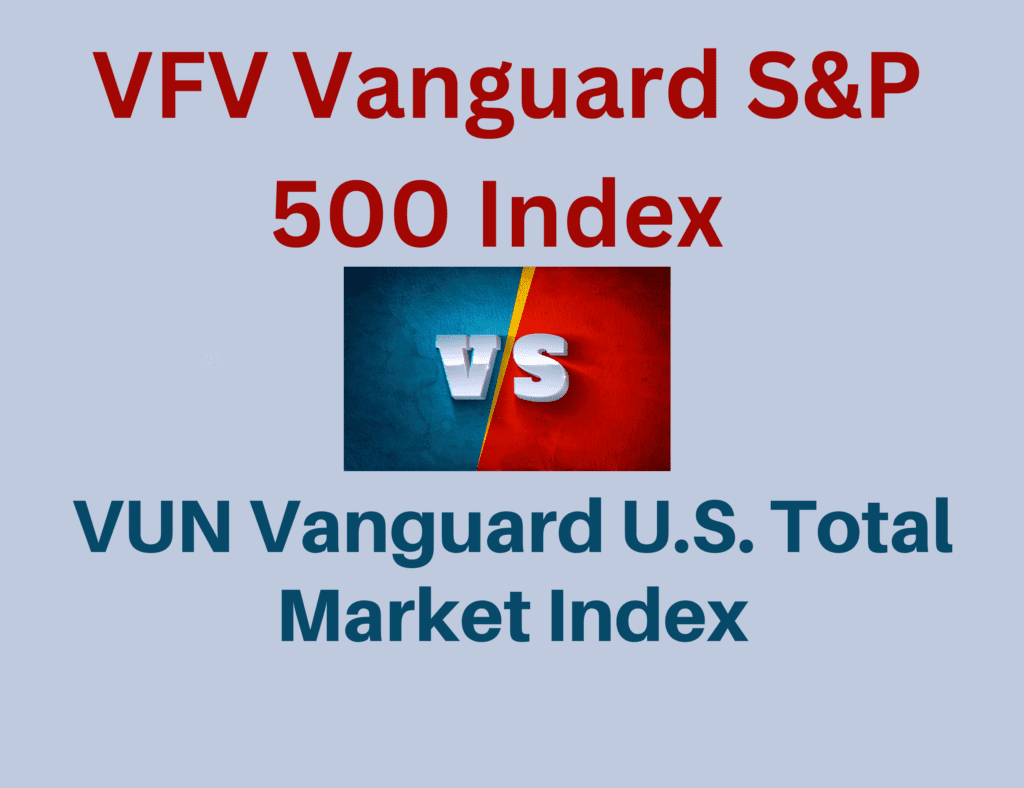Investing in the stock market has become increasingly popular over the years, and exchange-traded funds (ETFs) have become a popular way to gain exposure to various markets. Two of the most popular ETFs in Canada are the Vanguard U.S. Total Market Index ETF (VUN) and the Vanguard S&P 500 Index ETF (VFV). While both funds are managed by Vanguard, they differ in terms of their composition and investment strategies. In this article, we will compare VUN vs VFV to help investors decide which one is right for them.

Difference in investments objectives
Composition The VUN ETF aims to track the performance of the CRSP US Total Market Index, which includes approximately 3,500 stocks covering the entire US equity market. This means that VUN provides exposure to both large and small US companies across a variety of sectors.
On the other hand, the VFV ETF aims to track the performance of the S&P 500 Index, which includes 500 of the largest US companies, such as Apple, Microsoft, and Amazon. Therefore, VFV is heavily weighted towards large-cap companies in the US, which can make it more volatile than VUN.
The VUN ETF follows a passive investment strategy, which means it simply aims to replicate the performance of its underlying index. The fund holds a diverse range of US companies and maintains a long-term investment horizon.
The VFV ETF also follows a passive investment strategy, but it invests exclusively in large-cap US companies, making it more focused than VUN. VFV also has a higher concentration of technology stocks compared to VUN, which may be attractive to investors who believe that the tech industry will continue to grow.
Performance comparison VUN vs VFV

Portfolio holdings
VUN
| Holding Name | % of Market Value | Sector |
|---|---|---|
| Apple Inc. | 6.09% | Computer Hardware |
| Microsoft Corp. | 5.27% | Software |
| Amazon.com Inc. | 2.21% | Diversified Retailers |
| NVIDIA Corp. | 1.6% | Semiconductors |
| Alphabet Inc. | 1.52% | Consumer Digital Services |
| Tesla Inc. | 1.37% | Automobiles |
| Berkshire Hathaway Inc. | 1.32% | Diversified Financial Services |
| Alphabet Inc. | 1.29% | Consumer Digital Services |
Full Review of XEQT: iShares Core Equity ETF Portfolio
XIC vs XIU: Best Canadian Index ETFs
VFV
| Holding Name | % of Market Value | Sector |
|---|---|---|
| Apple Inc. | 7.09% | Computer Hardware |
| Microsoft Corp. | 6.2% | Software |
| Amazon.com Inc. | 2.66% | Diversified Retailers |
| NVIDIA Corp. | 1.97% | Semiconductors |
| Alphabet Inc. | 1.79% | Consumer Digital Services |
| Tesla Inc. | 1.61% | Automobiles |
| Berkshire Hathaway Inc. | 1.61% | Diversified Financial Services |
| Alphabet Inc. | 1.56% | Consumer Digital Services |
Sector allocation VUN vs VFV
| Sector | VFV | VUN |
| Information Technology | 26.10% | 27.35% |
| Health Care | 14.21% | 13.53% |
| Financials | 12.88% | 10.55% |
| Consumer Discretionary | 10.14% | 14.16% |
| Industrials | 8.66% | 13.27% |
| Communication Services | 8.11% | 2.36% |
| Consumer Staples | 7.23% | 5.52% |
| Energy | 4.61% | 4.70% |
| Utilities | 2.87% | 3.19% |
| Materials | 2.64% | 2.18% |
| Real Estate | 2.55% | 3.21% |

When comparing the sector allocation of the Vanguard S&P 500 Index ETF (VFV) to the Vanguard U.S. Total Market Index ETF (VUN), some notable differences are evident. VUN has a higher allocation to the Information Technology sector, with 27.35% compared to VFV’s 26.10%.
VFV also has a higher allocation to the Health Care sector at 14.21% compared to VUN’s 13.53%.
On the other hand, VUN has a higher allocation to Consumer Discretionary and Industrials, with 14.16% and 13.27%, respectively, compared to VFV’s 10.14% and 8.66%. This indicates that VUN provides more exposure to consumer spending and manufacturing sectors in the US economy.
Fees VUN vs VFV
Fees When investing in ETFs, it’s important to consider the fees associated with each fund. The VUN ETF has a management fee of 0.16%, which is slightly lower than the VFV ETF’s management fee of 0.08%. However, VFV has a slightly higher trading volume than VUN, which may make it more attractive to investors who value liquidity.
Conclusion
Conclusion In summary, both VUN and VFV ETFs offer exposure to the US stock market, but they differ in their composition, investment strategy, and fees. VUN provides exposure to a diverse range of US companies, while VFV is heavily weighted towards large-cap companies in the US. Both funds follow a passive investment strategy, but VFV is more focused than VUN. Investors should carefully consider their investment goals, risk tolerance, and investment horizon before deciding which ETF is right for them.

